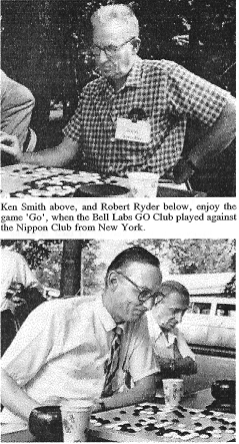|
In Memoriam - Kenneth D. Smith |
| Now that my old friend Ken Smith has passed away, this is the time when I should record a few memories of our friendship. I think of him first as a resourceful, reliable, and ingenious engineering collaborator from the early days of transistor development, in the 1950ís. We had to find how best to utilize these novel solid-state electronic amplifiers, with little to guide us other than what was known about the behavior of electrons in vacuum tubes, with which Ken had some twenty years of experience at that time. In the beginning, we had to find mechanical ways of putting the units together, so that they could be used in suitable electronic circuits, which also had to be developed at the same time. Ken was involved in building and measuring these experimental devices, learning their basic properties and limitations. Later he was involved in saving some of the original artifacts, as a record of how this work was done. Such teaching of how new principles are discovered is not often done in research labs, but is important for the education of future engineers and scientists. Research - finding new knowledge -- and teaching the new knowledge to young and curious new recruits to the field are naturally allied activities. Ken had long been an active radio "ham," interested in finding and using new ways to communicate over ever longer distances, and at ever higher frequencies. He had to be interested in a much broader spectrum of activities than just the amplifying devices themselves. He was also a well-informed amateur astronomer -- ground and polished his own telescope mirrors, and built his own telescopes. I believe he was instrumental in setting up the astronomical equipment in the Trailside Museum, in the nearby Watchung Reservation. This breadth of scientific interest showed itself in many ways. For example, Ken was the first to introduce diamond "heat sinks" for power transistors. When it was realized that the transistors were so small that it was difficult to prevent their operating temperature rise from limiting their performance, Ken knew that diamond was the best conductor of heat known, besides its more commonly known properties as a jewel stone. He built diamonds into the mounts of power transistors, and succeeded in reaching new levels of power performance. He also studied the various types of diamonds, to make best use of their favorable properties. The presence of such a skilled and resourceful staff member was one of the strengths of Bell Laboratories at the time. In more personal ways, Ken also contributed to the personal enjoyment of his friends. Soon after he joined Bell Laboratories the Great Depression of the 1930ís began. The Bell Labs management was well aware of its continuing need for resourceful people; so when the money dried up, the management put its staff on a four-day week, and finally for a time on a three-day week, to avoid the necessity of firing them to save money. In 1933, Macyís, the big New York Department store, staged a "game fair," to try to drum up some new business. Ken attended on one of his days off. At the fair, over in a corner of the big room was a young Japanese man, sitting behind a GO Ban, a decorative low table for use in playing the game of Go. He was being generally ignored, and looked quite lonesome. Ken went over and struck up a conversation about the game of GO. The young man was delighted to see him, and responded warmly. According to Ken, "He sat me down, and took a few minutes to tell me the rules. Then he gave me the beginnerís handicap of nine stones, showed me where to put the stones, and I beat him!" Out of this chance meeting eventually came the American GO Association, of which Ken and a number of other people at Bell Labs became enthusiastic supporters. Nowadays, in 1990, since a large number of high-ranking members of the Japanese government are also enthusiastic GO players, the game of GO is of increasing importance in promoting friendly contacts between Japan and the rest of the world. The passing of this tall, capable, resourceful, and friendly man is a loss not only to his friends, but also to his fellow citizens of the U S. It is a lasting pleasure to have known him. Robert M. Ryder 11/12/90 # |
|
Ken Smith above, and Robert Ryder below, enjoy the game 'Go', when the Bell Labs GO Club played against the Nippon Club from New York. |

